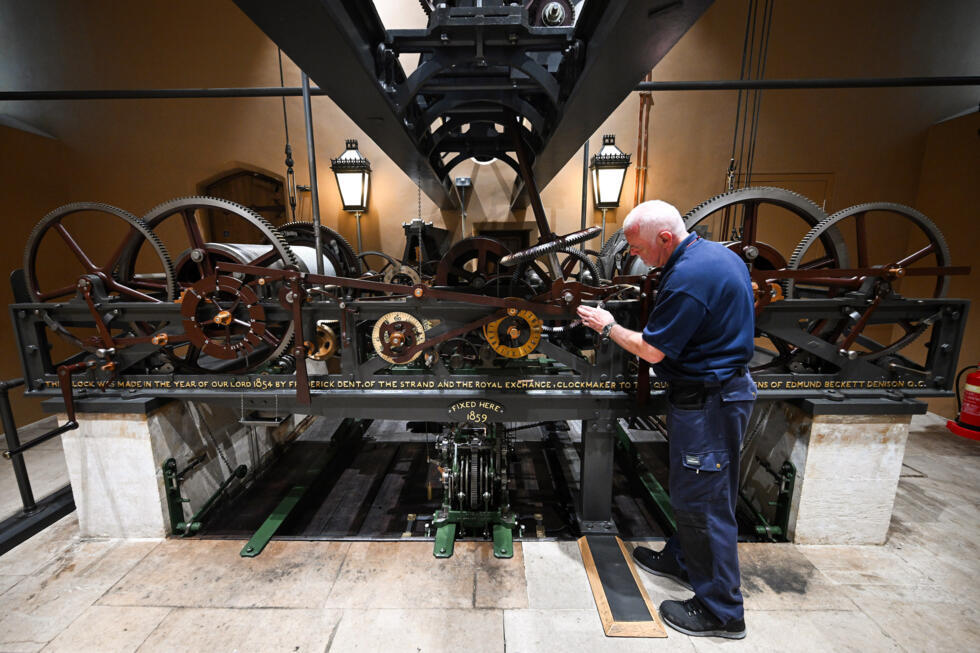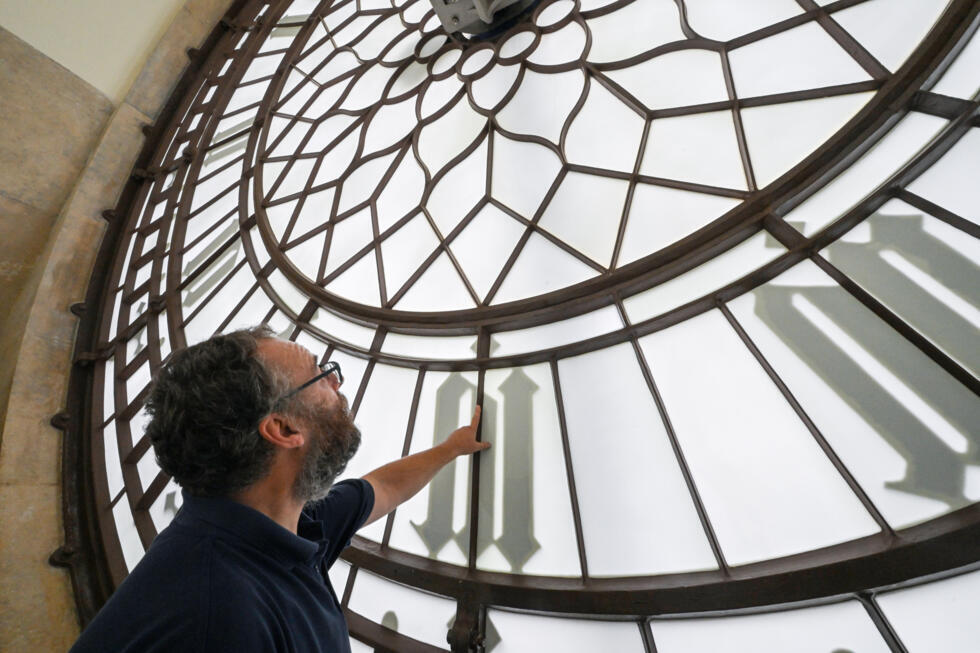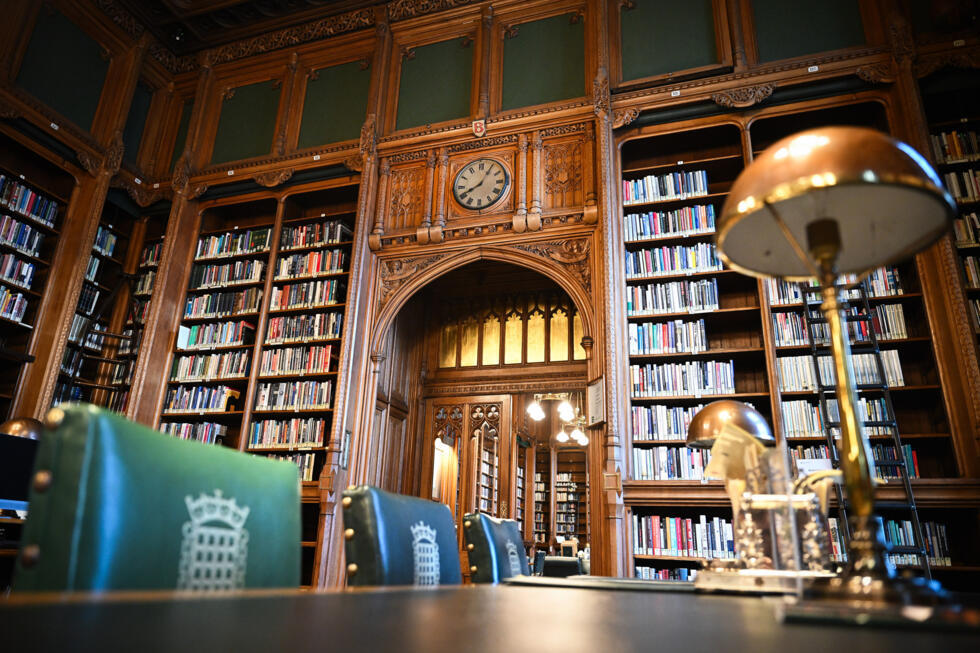The Tyranny Of Time
The clock is a useful social tool, but it is also deeply political. It benefits some, marginalizes others and blinds us from a true understanding of our own bodies and the world around us.

Marcos Guinoza for Noema Magazine
BY JOE ZADEHJUNE 3, 2021
Joe Zadeh is a writer based in Newcastle.
On a damp and cloudy afternoon on February 15, 1894, a man walked through Greenwich Park in East London. His name was Martial Bourdin — French, 26 years of age, with slicked-back dark hair and a mustache. He wandered up the zigzagged path that led to the Royal Observatory, which just 10 years earlier had been established as the symbolic and scientific center of globally standardized clock time — Greenwich Mean Time — as well as the British Empire. In his left hand, Bourdin carried a bomb: a brown paper bag containing a metal case full of explosives. As he got closer to his target, he primed it with a bottle of sulfuric acid. But then, as he stood facing the Observatory, it exploded in his hands.
The detonation was sharp enough to get the attention of two workers inside. Rushing out, they saw a park warden and some schoolboys running towards a crouched figure on the ground. Bourdin was moaning and screaming, his legs were shattered, one arm was blown off and there was a hole in his stomach. He said nothing about his identity or his motives as he was carried to a nearby hospital, where he died 30 minutes later.
Nobody knows for sure what Bourdin was trying to do that day. An investigation showed that he was closely linked to anarchist groups. Numerous theories circulated: that he was testing the bomb in the park for a future attack on a public place or was delivering it to someone else. But because he had primed the device and was walking the zigzagged path, many people — including the Home Office explosives expert, Vivian Dering Majendie, and the novelist Joseph Conrad, who loosely based his book “The Secret Agent” on the event — suspected that Bourdin had wanted to attack the Observatory.
Bourdin, so the story goes, was trying to bomb clock time, as a symbolic revolutionary act or under a naive pretense that it may actually disrupt the global measurement of time. He wasn’t the only one to attack clocks during this period: In Paris, rebels simultaneously destroyed public clocks across the city, and in Bombay, protestors shattered the famous Crawford Market clock with gunfire.
Around the world, people were angry about time.
The destruction of clocks seems outlandish now. Contemporary society is obsessed with time — it is the most used noun in the English language. Since clocks with dials and hands first appeared on church towers and town halls, we have been bringing them closer toward us: into our workplaces and schools, our homes, onto our wrists and finally into the phone, laptop and television screens that we stare at for hours each day.
We discipline our lives by the time on the clock. Our working lives and wages are determined by it, and often our “free time” is rigidly managed by it too. Broadly speaking, even our bodily functions are regulated by the clock: We usually eat our meals at appropriate clock times as opposed to whenever we are hungry, go to sleep at appropriate clock times as opposed to whenever we are tired and attribute more significance to the arresting tones of a clock alarm than the apparent rising of the sun at the center of our solar system. The fact that there is a strange shame in eating lunch before noon is a testament to the ways in which we have internalized the logic of the clock. We are “time-binding” animals, as the American economist and social theorist Jeremy Rifkin put it in his 1987 book, “Time Wars.” “All of our perceptions of self and world are mediated by the way we imagine, explain, use and implement time.”
“The clock does not measure time; it produces it.”
During the COVID-19 pandemic, many people have reported that their experience of time has become warped and weird. Being trapped at home or laboring unusually excessive hours makes days feel like hours and hours like minutes, while some months feel endless and others pass almost without notice. It seems the time in our clocks and the time in our minds have drifted apart.
Academic studies have explored how our emotions (such as pandemic-induced grief and anxiety) could be distorting our perception of time. Or maybe it is just because we aren’t moving around and experiencing much change. After all, time is change, as Aristotle thought — what is changeless is timeless. But rarely does the clock itself come into question — the very thing we use to measure time, the drumbeat against which we define “weird” distortions. The clock continues to log its rigid seconds, minutes and hours, utterly unaware of the global crisis that is taking place. It is stable, correct, neutral and absolute.
But what makes us wrong and the clock right? “For most people, the last class they had devoted to clocks and time was early in primary school,” Kevin Birth, a professor of anthropology at the City University of New York who has been studying clocks for more than 30 years, told me recently. “There’s this thing that is central to our entire society, that’s built into all of our electronics. And we’re wandering around with an early primary school level of knowledge about it.”
Birth is one of a growing chorus of philosophers, social scientists, authors and artists who, for various reasons, are arguing that we need to urgently reassess our relationship with the clock. The clock, they say, does not measure time; it produces it. “Coordinated time is a mathematical construct, not the measure of a specific phenomenon,” Birth wrote in his book “Objects of Time.” That mathematical construct has been shaped over centuries by science, yes, but also power, religion, capitalism and colonialism. The clock is extremely useful as a social tool that helps us coordinate ourselves around the things we care about, but it is also deeply politically charged. And like anything political, it benefits some, marginalizes others and blinds us from a true understanding of what is really going on.
The more we synchronize ourselves with the time in clocks, the more we fall out of sync with our own bodies and the world around us. Borrowing a term from the environmentalist Bill McKibben, Michelle Bastian, a senior lecturer at Edinburgh University and editor of the academic journal Time & Society, has argued that clocks have made us “fatally confused” about the nature of time. In the natural world, the movement of “hours” or “weeks” do not matter. Thus the build-up of greenhouse gases in the atmosphere, the sudden extinction of species that have lived on Earth for millions of years, the rapid spread of viruses, the pollution of our soil and water — the true impact of all of this is beyond our realm of understanding because of our devotion to a scale of time and activity relevant to nothing except humans.
During an era in which social constructs like race, gender and sexuality are being challenged and dismantled, the true nature of clock time has somehow escaped the attention of wider society. Like money, the clock has come to be seen as the thing it was only supposed to represent: The clock has become time itself.
Clock time is not what most people think it is. It is not a transparent reflection of some sort of true and absolute time that scientists are monitoring. It was created, and it is frequently altered and adjusted to fit social and political purposes. Daylight savings, for instance, is an arbitrary thing we made up. So is the seven-day week. “People tend to think that somewhere there is some master clock, like the rod of platinum in the Bureau of Weights and Measures, that is the ‘uber clock,’” Birth told me. “There isn’t. It’s calculated. There is no clock on Earth that gives the correct time.”
What’s usually taught in Western schools is that the time in our clocks (and by extension, our calendars) is determined by the rotation of the Earth, and thus the movement of the sun across our sky. The Earth, we learn, completes an orbit of the sun in 365 days, which determines the length of our year, and it rotates on its axis once every 24 hours, which determines our day. Thus, an hour is 1/24 of this rotation, a minute is 1/60 of an hour and a second is 1/60 of a minute.
None of this is true. The Earth is not a perfect sphere with perfect movement; it’s a lumpy round mass that is squashed at both poles and wobbles. It does not rotate in exactly 24 hours each day or orbit the sun in exactly 365 days each year. It just kinda does. Perfection is a manmade concept; nature is irregular.
For thousands of years, most human societies have accepted and moved in harmony with the irregular rhythms of nature, using the sun, moon and stars to understand the passage of time. One of the most common early timekeeping devices, sundials (or shadow clocks), reflected this: The hours of the day were not of fixed 60-minute lengths, but variable. Hours were longer or shorter as they waxed and waned in accordance with the Earth’s orbit, making the days feel shorter in the winter and longer in the summer. These clocks didn’t determine the hours, minutes and seconds themselves, they simply mirrored their surrounding environment and told you where you were within the cyclical rhythms of nature.
But since the 14th century, we’ve gradually been turning our backs on nature and calculating our sense of time via manmade devices. It began in the monasteries of Northern and Central Europe, where pious monks built crude iron objects that unreliably but automatically struck intervals to help bellringers keep track of canonical hours of prayer. Like any machine, the logic of the mechanical clock was based upon regularity, the rigid ticking of an escapement. It brought with it a whole different way to view time, not as a rhythm determined by a combination of various observed natural phenomena, but as a homogenous series of perfectly identical intervals provided by one source.
The religious fervor for rationing time and disciplining one’s life around it led the American historian Lewis Mumford to describe the Benedictine monks as “perhaps the original founders of modern capitalism.” It is one of the great ironies of Christianity that it set the wheels in motion for an ever-unfolding mania of scientific accuracy and precision around timekeeping that would eventually secularize time in the West and divorce God, the original clockmaker, from the picture entirely.
“The more we synchronize ourselves with the time in clocks, the more we fall out of sync with our own bodies and the world around us.”
By 1656, the Dutch scientist Christiaan Huygens had invented the first pendulum clock, which delivered homogenous and regular slices of a small unit of time: seconds. Unlike the inconsistent mechanical clocks of before, the clock time of pendulums was nearly perfect. In that same century, the British astronomer John Flamsteed and others developed “mean time,” an average calculation of the Earth’s rotation. Science had found a way around the Earth’s wobbly eccentricities, producing a quantifiable and consistent unit that became known as Greenwich Mean Time.
Standardized time became vital for seafarers and irresistible to corporate interests, such was the ease it could offer trade, transport and electric communication. But it took longer to colonize the minds of the general public. During the British “railway mania” of the 1840s, around 6,000 miles of railway lines were constructed across the country. Investors (including Charles Darwin, John Stuart Mill and the Brontë sisters) climbed over each other to acquire rail company shares in a frenzy of freewheeling capitalism that caused one of the biggest economic bubbles in British history. Companies like Great Western Railway and Midland Railway began to enforce Greenwich Mean Time inside their stations and on their trains to make timetables run efficiently.
Every city, town and village in Britain used to set its clocks to its own local solar time, which gave each locale a palpable sense of identity, time and place. If you lived in Newcastle, noon was when the sun was highest, no matter what the time in London was. But as the railways brought standardized timetables, local times were demonized and swept aside. By 1855, nearly all public clocks were set to GMT, or “London time,” and the country became one time zone.
The rebellious city of Bristol was one of the last to agree to standardized time: The main town clock on the Corn Exchange building kept a third hand to denote “Bristol time” for the local population who refused to adjust. It remains there to this day.
“Railway time” arrived in America too, splitting the country into four distinct time zones and causing protests to flare nationwide. The Boston Evening Transcript demanded, “Let us keep our own noon,” and The Cincinnati Commercial Gazette wrote, “Let the people of Cincinnati stick to the truth as it is written by the sun, moon and stars.”
The 1884 International Meridian Conference is often framed as the moment clock time took over the world. The globe was sliced into 24 time zones declaring different clock times, all synchronized to the time of the most powerful empire, the British and their GMT. Nobody would decipher time from nature anymore — they would be told what time it was by a central authority. The author Clark Blaise has argued that once this was implemented, “It didn’t matter what the sun proclaimed at all. ‘Natural time’ was dead.”
“Clock time is not what most people think it is. It was created, and it is frequently altered and adjusted to fit social and political purposes.”
In reality, this process had already been taking place throughout the 1800s as a result of European colonialism, imperialism and oppression. Colonialism was not just a conquest of land, and therefore space, but also a conquest of time. From South Asia to Africa to Oceania, imperialists assaulted alternative forms of timekeeping. They saw any region without European-style clocks, watches and church bells as a land without time.
“European global expansion in commerce, transport and communication was paralleled by, and premised upon, control over the manner in which societies abroad related to time,” the Australian historian Giordano Nanni wrote in his book, “The Colonization of Time.” “The project to incorporate the globe within a matrix of hours, minutes and seconds demands recognition as one of the most significant manifestations of Europe’s universalizing will.” In short, if the East India Company was the physical embodiment of British colonialism overseas, GMT was the metaphysical embodiment.
The Western separation of clock time from the rhythms of nature helped imperialists establish superiority over other cultures. When British colonizers swept into southeastern Australia in search of gold, they depicted the timekeeping practices of the Indigenous societies they encountered as irregular and unpredictable in contrast to the rational and linear nature of the clock. This was despite the fact that Indigenous societies in the region had advanced forms of timekeeping based on the moon, stars, rains, the blossoming of certain trees and shrubs and the flowing of tides, which they used to determine the availability of food and resources, distance and calendar dates.
“Nineteenth-century Europeans generally conceived of such closeness to nature as calling into question the very humanity of those who practiced it,” Nanni wrote. “This was partly determined by the fact that Enlightenment values and ideals had come to associate the idea of ‘humanness’ with man’s transcendence and domination over nature; and its corresponding opposite — savagery — as a mode of life that existed ‘closer to nature.’”
In Melbourne, churches and railway stations grew quickly on the horizon, bringing with them the hands, faces, bells and general cacophony of clock time. By 1861, a time ball was installed in the Williamstown Lighthouse and Melbourne was officially synchronized to Greenwich Mean Time. British colonizers attempted to integrate Indigenous peoples into their labor force with unsatisfactory results due to their unwillingness to sacrifice their own form of timekeeping. They did not believe in “meaningless toil” and “obedience to the clock,” wrote the Australian sociologist Mike Donaldson. “To them, time was not a tyrant.”
In some parts of Australia, the Indigenous resistance to Western clock time continued defiantly. In 1977, in the tiny town of Pukatja (then known as Ernabella) a giant, revolving, electronically operated clock was constructed near the town center for the local Pitjantjatjara people to coordinate their lives around. A decade later, a white construction worker at a town council meeting noted that the clock had been broken for months. Nobody had noticed, because nobody looked at it.
“Nineteenth-century Europeans generally conceived of such closeness to nature as calling into question the very humanity of those who practiced it.”
— Giordano Nanni
The movement toward standardized time reached its apex in the 1950s, when atomic clocks were judged to be better timekeepers than the Earth itself. The second, as a unit of time, was redefined not as a fraction of the Earth’s orbit around the sun, but as a specific number of oscillations of cesium atoms inside an atomic clock.
“When you look at precision timekeeping, it’s all about insulating and isolating these clocks from responding to anything that goes on around them,” Bastian told me via a video call from her home in Edinburgh. A poster with the words “A clock that falls asleep” hung on the wall behind her. “You have to keep them separate from temperature, fluctuations, humidity, even quantum gravity effects. They can’t respond to anything.”
Over 400 atomic clocks in laboratories around the world count time using the atomic second as their standard. A weighted average of these times is used to create International Atomic Time, which forms the basis of Coordinated Universal Time (UTC). UTC isn’t completely non-responsive. Every few years, a leap second is added to it to keep it reasonably close to the rotations of the Earth. But in 2023, at the World Radiocommunication Conference, nations from around the world will discuss whether it is in our best interest to abolish leap seconds and permanently unmoor ourselves from the sun and moon in favor of time we manufacture ourselves.
“It’s easier to imagine the end of the world than the end of capitalism,” wrote the literary critic Fredric Jameson. One of the hardest elements to imagine is what capitalism has done to our perception of time via clocks. It now seems embedded into our very psychology to view time as a commodity that can be spent or wasted.
Capitalism did not create clock time or vice versa, but the scientific and religious division of time into identical units established a useful infrastructure for capitalism to coordinate the exploitation and conversion of bodies, labor and goods into value. Clock time, the British sociologist Barbara Adam has argued, connected time to money. “Time could become commodified, compressed and controlled,” she wrote in her book “Time.” “These economic practices could then be globalized and imposed as the norm the world over.”
Clock time, Adam goes on, is often “taken to be not only our natural experience of time” but “the ethical measure of our very existence.” Even the most natural of processes now must be expressed in clock time in order for them to be validated.
Women in particular often find themselves at the wrong end of this arbitrary metric. Unpaid labor such as housework and childcare — which still disproportionately burdens women — seems to slip between the measurements of the clock, whereas the experience of pregnancy is very much under the scrutiny of clock time. Adam quotes a woman’s account of her birth-giving experience: “The woman in labor, forced by the intensity of the contractions to turn all her attention to them, loses her ordinary, intimate contact with clock time.” But in the hospital environment, where the natural process of childbirth has been evaluated and standardized in clock-time units, a woman is pressured to follow what Alys Einion-Waller, a professor of midwifery at Swansea University, has called a “medicalized birth script.”
“It now seems embedded into our very psychology to view time as a commodity that can be spent or wasted.”
The firsthand experience and intuition of a woman giving birth is devalued in favor of timings and measurements related to the expected length of labor stages, the spacing of contractions, the progress of cervical dilation and other observations. Language such as “failure to progress” is common when a woman doesn’t perform to the expected curve, and diversion from the clock-time framework can be used to justify medical intervention. This is one of the reasons that the home-birthing movement has recently grown in popularity.
Likewise, new parents know that the baby itself becomes their clock, and any semblance of standardized time is preposterous. But in time, of course, the baby joins the rigid temporal hierarchy of school, with non-negotiable class and mealtimes, forcing biological rhythms to adhere to socially acceptable clock time.
As Birth put it to me: “The clock helps us with things that are uniform in duration. But anything that is not uniform, anything that varies, the clock screws up. … When you try to schedule a natural process, nature doesn’t cooperate.”
In 2002, scientists watched in amazement as Larsen B, an ice shelf on the Antarctic Peninsula 55 times bigger than Manhattan — which had been stable for 10,000 years — splintered and collapsed into hundreds of shards the size of skyscrapers. A glaciologist who flew overhead told Scientific American that he could see whales swimming in water where ice a thousand feet thick had been just days earlier.
Virtually overnight, previous clock-time predictions around the mass loss of ice needed to be rewritten to acknowledge a 300% acceleration in the rate of change. In 2017, a piece of the nearby Larsen C ice shelf fell off, creating the world’s biggest iceberg — so big that maps had to be redrawn. The Intergovernmental Panel on Climate Change calls such abrupt events, which happen more often than you might think, “surprises.”
The climate crisis is a realm in which linear clock time frequently and fatally misfires. It frames the crisis as something that is measurable, quantifiable and predictable — something we can envisage in the same way as work hours, holidays, chores and projects. Warming temperatures, ocean acidification, ice melting and carbon dioxide levels in the atmosphere are constantly being translated into clock time to create tipping points, thresholds, roadmaps and sustainable development goals for us to beat or aspire to. When a “surprise” happens, time estimates crumble in the face of reality. Nature doesn’t cooperate.
It works the same way for putting limits on the amount of time we have to stop global warming. The Guardian launched a blog called “100 months to save the world” in July 2008 that used scientific research and predictions to make it “possible to estimate the length of time it will take to reach a tipping point.” That was 154 months ago. Are we 54 months into the end of the world? Perhaps. But one can’t help but wonder if the constant framing of the climate crisis in clock time deadlines, which then pass without comment, has contributed to the inability and inertia of many to comprehend the seriousness of what is actually happening.
“It’s a privilege to live by clock time alone and ignore nature’s urgent temporalities.”
“We can’t say that clock time isn’t important,” Vijay Kolinjivadi, a researcher at the University of Antwerp’s Institute of Development Policy, told me. “There’s certain times when that metric makes a lot of sense, and we should use it. For instance, you and I decided to talk at 10 a.m. There’s no way to escape that. But when we are thinking about capitalism, social crisis and ecological breakdown, it gets problematic.” Clock time, he went on, “is always geared toward production, growth and all the things that created this ecological crisis in the first place.”
One of the most affecting myths of clock time is that we all experience time at the same steady pace. We don’t. “The future is already here,” the science-fiction author William Gibson famously said in 2003, “it’s just not very evenly distributed.” And framing the climate crisis as a ticking clock with only a certain amount of time “to avoid disaster” ignores those for whom disaster has already arrived. The reality is that it’s a privilege to live by clock time alone and ignore nature’s urgent temporalities.
Every few years, the American Midwest is ravaged by floods as the Missouri River swells from intense rainfall, upending the lives of millions. When the floods came during the summer of 1993, a New York Times journalist interviewed a resident about the night he was evacuated. “He remembers everything about the night the river forced him and his wife out of the house where they had lived for 27 years — except for this. ‘I can’t tell you what day it was. … All I can tell you is that the river stage was 26 [feet] when we left.’” The headline of the article was, “They Measure Time by Feet.”
In 1992, the astrophysicist turned author Alan Lightman published a novel called “Einstein’s Dreams” in which he fictionalizes a young Albert Einstein dreaming about the multitude of ways that different interpretations of time would play out in the lives of those around him. In one dream, Einstein sees a world where time is not measured — there are “no clocks, no calendars, no definite appointments. Events are triggered by other events, not by time. A house is begun when stone and lumber arrive at the building site. The stone quarry delivers stone when the quarryman needs money. … Trains leave the station at the Bahnhofplatz when the cars are filled with passengers.” In another, time is measured, but by “the rhythms of drowsiness and sleep, the recurrence of hunger, the menstrual cycles of women, the duration of loneliness.”
Recently, there have been many attempts in both art and literature to reimagine the clock and the role it plays in our lives. At the end of 2020, the artist David Horvitz exhibited a selection of clocks he had created, which included one that was synchronized to a heartbeat. Another artist, Scott Thrift, has developed a clock called “Today,” which simplifies the passage of time into dawn, noon, dusk and midnight as opposed to seconds, minutes and hours. It moves at half the speed of a regular clock, making one full rotation in a day.
Bastian herself has proposed clocks that are more responsive to the temporalities of the climate crisis, like a clock synchronized with the population levels of endangered sea turtles, an animal that has lived in the Pacific Ocean for 150 million years but now faces extinction due to temperature changes. These and other proposals all have the same idea at their core: There are more ways to arrange and synchronize ourselves with the world around us than the abstract clock time we hold so dear.
“They have been trapped by their own inventiveness and audacity. And they must pay with their lives.”
— Alan Lightman
Clock time may have colonized the planet, but it did not completely destroy alternative traditions of timekeeping. Certain religions maintain a connection to time that is rooted in nature, like salat in Islam and zmanim in Judaism, in which prayer times are defined by natural phenomena like dawn, dusk and the positioning of stars. The timing of these events may be converted into clock time, but they are not determined by clocks.
In places where globally standardized time is enforced, some still rebel, like in China, where the entire country is under one time zone, BST (Beijing Standard Time). In Xinjiang, nearly 2,000 miles west of Beijing, where the sun sometimes sets at midnight according to BST, many Uighur communities use their own form of local solar time.
And Indigenous communities around the world still use ecological calendars, which keep time through observations of seasonal changes. Native American tribes around Lake Oneida, for example, recognize a certain flower blooming as the time to start plowing and setting traps for animals emerging from hibernation. As opposed to a standardized clock and calendar format, these ecological calendars, by their very nature, reflect and respond to an ever-changing climate.
In one of the last dreams in Lightman’s book, Einstein imagines a world not too dissimilar from our own, where one “Great Clock” determines the time for everyone. Every day, tens of thousands of people line up outside the “Temple of Time” where the Great Clock resides, waiting their turn to enter and bow before it. “They stand quietly,” wrote Lightman, “but secretly they seethe with their anger. For they must watch measured that which should not be measured. They must watch the precise passage of minutes and decades. They have been trapped by their own inventiveness and audacity. And they must pay with their lives.
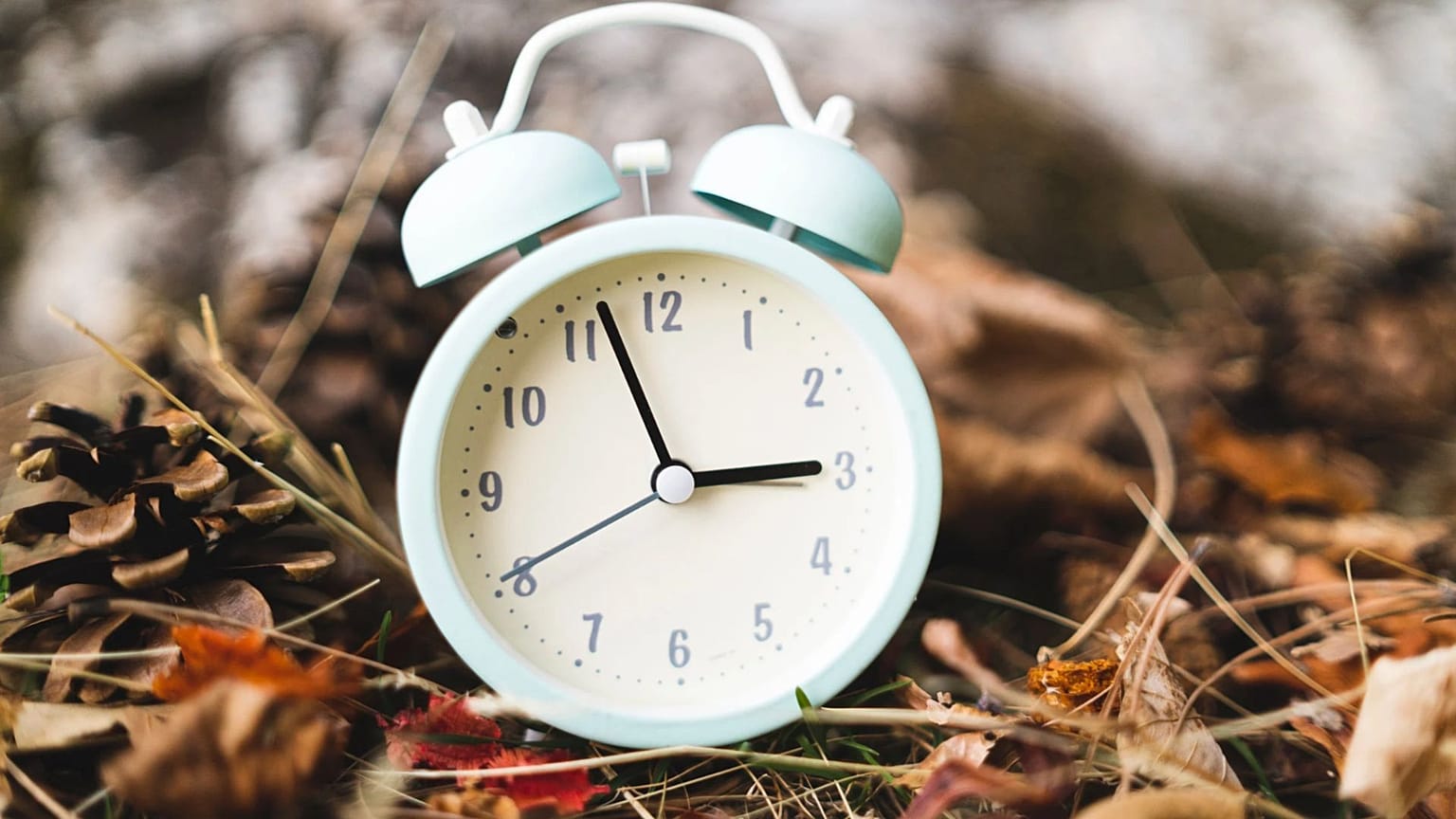
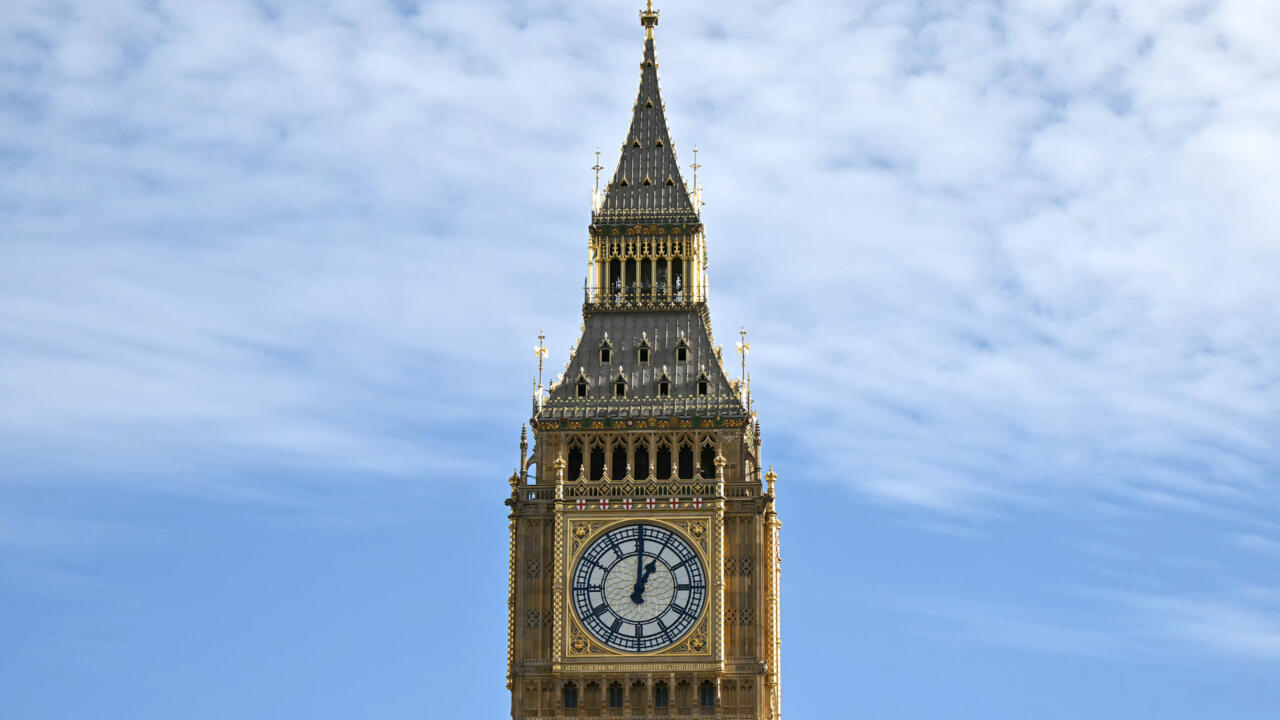 Popularly known as Big Ben, the clock towers of the British capital © JUSTIN TALLIS / AFP
Popularly known as Big Ben, the clock towers of the British capital © JUSTIN TALLIS / AFP